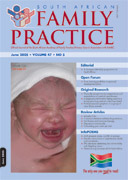CPD: Infantile colic.
Abstract
Infantile colic can be distressing to parents whose infant is inconsolable during crying episodes. Colic is often defined by the "rule of three": crying for more than three hours per day, for more than three days per week, and for longer than three weeks in an infant who is well-fed and otherwise healthy. The physician's role is to ensure that there is no organic cause for the crying, offer balanced advice on treatments, and provide support to the family. Colic is a diagnosis of exclusion that is made after performing a careful history and physical examination to rule out less common organic causes. Treatment is limited. Feeding changes usually are not advised. Medications available in the United States have not been proved effective in the treatment of colic, and most behaviour interventions have not been proved to be more effective than placebo. Families may turn to untested resources for help, and the physician should offer sound advice about these treatments. Above all, parents need reassurance that their baby is healthy and that colic is self-limited with no long-term adverse effects. Physicians should watch for signs of continuing distress in the child and family, particularly in families whose resources are strained already. (SA Fam Pract 2005;47(5): 22-26) (Reprinted from: Am Fam Physician 2004;70(4):735-40. Copyright© 2004 American Academy of Family Physicians.) Permission from the AAFP was granted to publish this article in the hardcopy only. Kindly refer to www.aafp.org or subscribe to the hardcopy of South African Family Practice.
Published
2005-06-01
Issue
Section
Review Articles
By submitting manuscripts to SAFP, authors of original articles are assigning copyright to the South African Academy of Family Physicians. Copyright of review articles are assigned to the Publisher, Medpharm Publications (Pty) Ltd, unless otherwise specified. Authors may use their own work after publication without written permission, provided they acknowledge the original source. Individuals and academic institutions may freely copy and distribute articles published in SAFP for educational and research purposes without obtaining permission.

